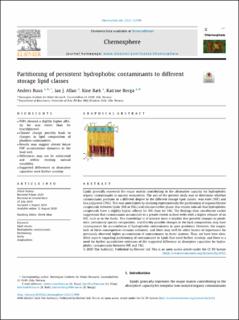| dc.contributor.author | Ruus, Anders | |
| dc.contributor.author | Allan, Ian | |
| dc.contributor.author | Bæk, Kine | |
| dc.contributor.author | Borgå, Katrine | |
| dc.date.accessioned | 2020-08-24T07:23:40Z | |
| dc.date.available | 2020-08-24T07:23:40Z | |
| dc.date.created | 2020-08-21T09:13:44Z | |
| dc.date.issued | 2021 | |
| dc.identifier.citation | Chemosphere. 2021, 263, 127890. | en_US |
| dc.identifier.issn | 0045-6535 | |
| dc.identifier.uri | https://hdl.handle.net/11250/2673477 | |
| dc.description.abstract | Lipids generally represent the major matrix contributing to the absorptive capacity for hydrophobic organic contaminants in aquatic ecosystems. The aim of the present study was to determine whether contaminants partition to a different degree to the different storage lipid classes: wax ester (WE) and triacylglycerol (TAG). This was undertaken by studying experimentally the partitioning of organochlorine compounds between lipids (WE or TAG) and silicone rubber phase. Our results indicate that hydrophobic compounds have a slightly higher affinity for WE than for TAG. The findings thus corroborate earlier suggestions that contaminants accumulate to a greater extent in food webs with a higher reliance of on WE, such as in the Arctic. This knowledge is of interest since it implies that possible changes in planktonic community species composition, and thereby possible changes in the lipid composition, may have consequences for accumulation of hydrophobic contaminants in apex predators. However, the magnitude of these consequences remains unknown, and there may well be other factors of importance for previously observed higher accumulation of contaminants in Arctic systems. Thus, we have here identified aspects regarding partitioning of contaminants to lipids that need further scrutiny, and there is a need for further quantitative estimates of the suggested difference in absorptive capacities for hydrophobic contaminants between WE and TAG. | en_US |
| dc.language.iso | eng | en_US |
| dc.publisher | Elsevier | en_US |
| dc.rights | Navngivelse 4.0 Internasjonal | * |
| dc.rights.uri | http://creativecommons.org/licenses/by/4.0/deed.no | * |
| dc.title | Partitioning of persistent hydrophobic contaminants to different storage lipid classes | en_US |
| dc.type | Peer reviewed | en_US |
| dc.type | Journal article | en_US |
| dc.description.version | publishedVersion | en_US |
| dc.source.pagenumber | 7 | en_US |
| dc.source.volume | 263 | en_US |
| dc.source.journal | Chemosphere | en_US |
| dc.identifier.doi | 10.1016/j.chemosphere.2020.127890 | |
| dc.identifier.cristin | 1824399 | |
| dc.relation.project | Norges forskningsråd: 234388 | en_US |
| cristin.ispublished | true | |
| cristin.fulltext | original | |
| cristin.qualitycode | 1 | |

